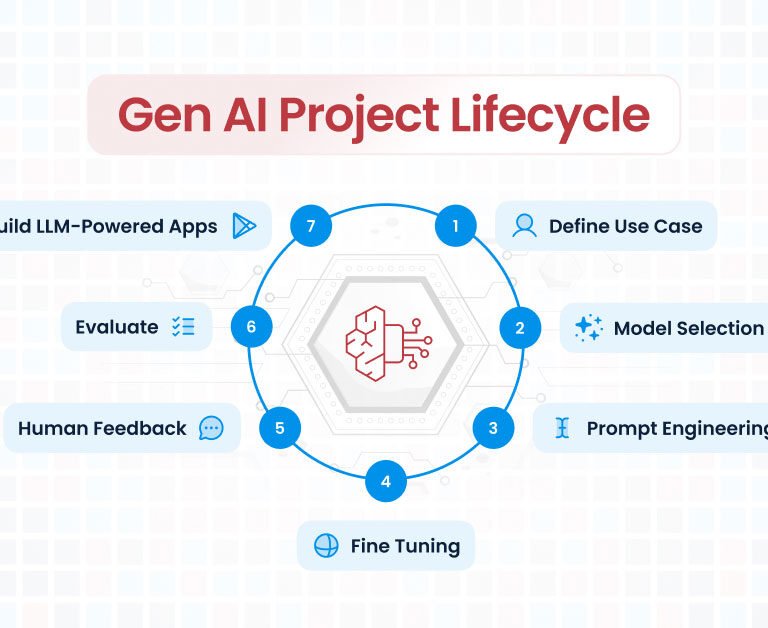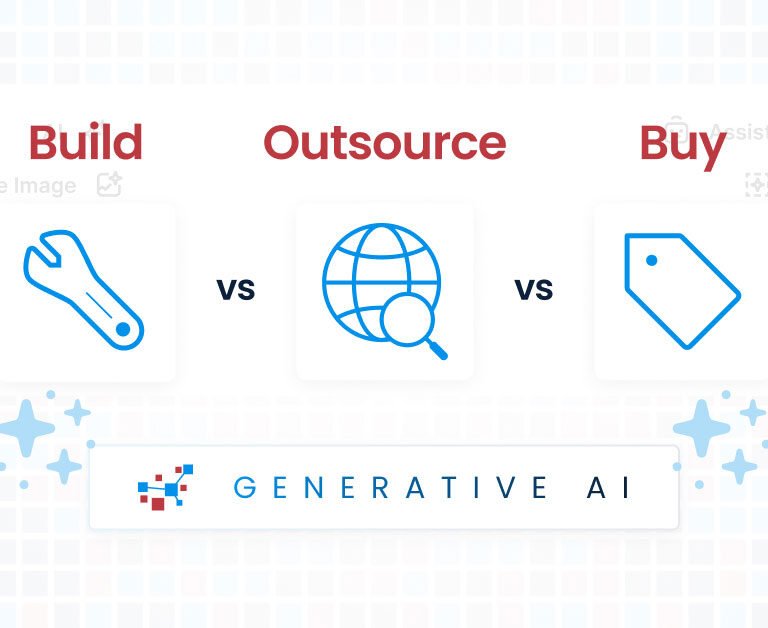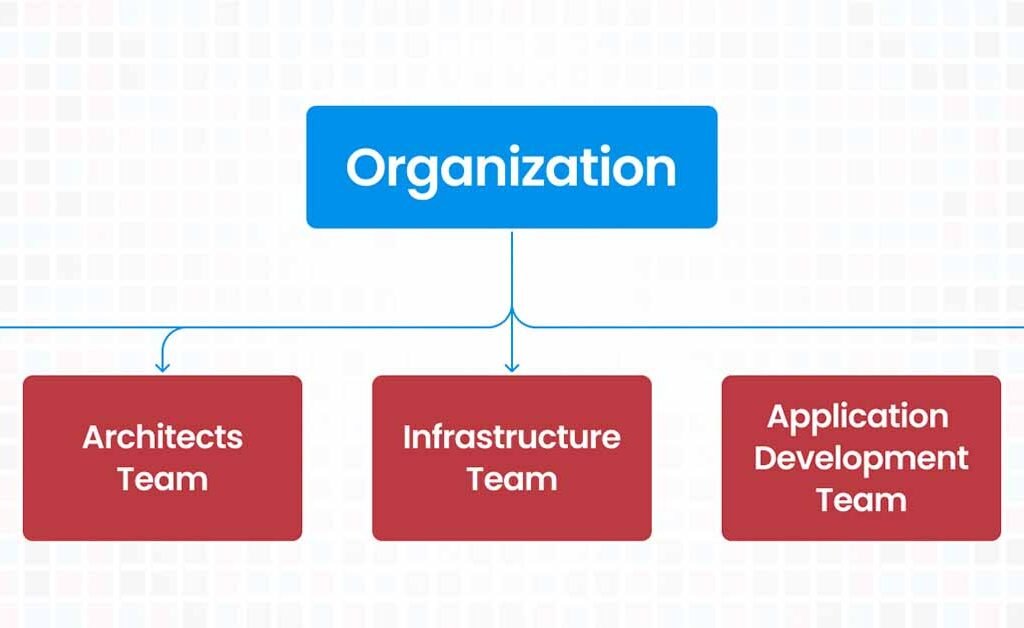
The traditional waterfall model, with its sequential and structured approach, has long influenced the organizational structure of IT departments in many businesses. In such a setup, responsibilities are typically distributed horizontally across various specialized teams. While this structure has the advantage of specialization, it also brings about inherent challenges related to hard coupling and interdependencies among teams.
Waterfall Based Team Structure
In a typical waterfall-based structure, we see a clear demarcation of roles and responsibilities:
- Architects Team: The Architecture Team in an organization plays a crucial role in the planning, design, and implementation of IT systems and infrastructure. This team typically consists of experienced architects, such as Solutions Architects, Enterprise Architects, and Technical Architects, each specializing in different aspects of IT architecture.
- Infrastructure Team: This team is the backbone of the department, handling all hardware-related aspects. Their work includes managing servers, networks, and ensuring all physical and virtual components are running smoothly.
- Application Development Team: Focused on application development, this team translates user requirements and business needs into software solutions, often working in a siloed phase of the development lifecycle.
Security Team: Tasked with safeguarding the system, the security team works on implementing and maintaining robust security protocols to protect the organization from cyber threats. - Site Reliability Engineering (SRE) Team: This team ensures that the deployed applications are reliable and available around the clock. They handle operational aspects, including monitoring, performance, and incident response.
- Quality Assurance Team: The QA team conducts various tests to identify bugs and issues in the software. This includes functional testing to verify that each feature works as intended, performance testing to ensure the software can handle expected loads, and usability testing to check if the user experience is intuitive and error-free.
- DevOps Team: Bridging the gap between software development and operations, the DevOps team focuses on streamlining software releases and managing CI/CD (Continuous Integration/Continuous Deployment) pipelines.
Dependency Challenge
While each team has a critical role, this horizontal distribution leads to a tightly coupled system where dependencies are inherent:
- Sequential Dependence: Each phase of the project must be completed before the next can begin. For instance, the architecture team must complete design before software team can do their work and software teams must complete development before the DevOps team can begin deployment automation, creating bottlenecks.
- Misaligned Objectives: Each team, focusing on its area of expertise, might prioritize its goals, which aren’t always aligned with the overall project or product deliverables.
- Communication Barriers: The need for constant communication across teams often leads to challenges, especially when each team has its timeline and priorities.
- Integration Issues: Bringing together the different components created by each team can be challenging, particularly if there are inconsistencies or disparities in the work produced.
The landscape of IT project management is continuously evolving, and a significant shift is seen from the traditional waterfall model towards Agile development practices. One of the key features of Agile methodologies is the formation of cross-functional teams. Unlike the siloed approach in waterfall structures, Agile promotes collaboration and integration among various specialties. Let’s delve into how this Agile-based structure benefits IT projects and organizations.
Agile Cross-Functional Teams
Agile development is characterized by its flexibility, adaptability, and rapid response to change. Central to this approach is the concept of cross-functional teams. These are small, nimble groups composed of professionals from different disciplines, such as developers, testers, designers, and business analysts, working cohesively towards a shared objective.
Key Characteristics of Cross-Functional Agile Teams:
- Diverse Expertise: Each member brings a unique skill set, providing a comprehensive approach to problem-solving.
- Collaborative Environment: Team members collaborate closely, which fosters a deeper understanding and respect for each other’s work.
- Autonomy and Accountability: These teams often manage themselves, promoting a sense of ownership and responsibility for the project’s success.
- Focus on Customer Value: Agile teams prioritize customer needs and feedback, ensuring that the product aligns with market demands.
Advantages of Agile Cross-Functional Teams
- Enhanced Communication and Collaboration: The barrier between different departments is broken down, fostering better communication and collaboration. This leads to more innovative solutions and faster problem resolution.
- Increased Flexibility and Adaptability: Agile teams can pivot quickly in response to feedback or changes in the project scope, making them highly adaptive to change.
- Faster Time-to-Market: With an emphasis on iterative development and MVPs (Minimum Viable Products), Agile teams can deliver products to market faster.
- Continuous Improvement: Regular retrospectives are a staple in Agile, allowing teams to reflect on their performance and continuously improve their processes.
- Higher Employee Satisfaction: Working in a dynamic, collaborative environment often leads to higher job satisfaction among team members.
Implementing Agile Cross-Functional Teams
- Encourage a Shift in Mindset: Moving from a waterfall to an Agile approach requires a cultural shift in the organization, prioritizing flexibility, collaboration, and continuous learning.
- Provide Training and Resources: Teams should be given adequate training in Agile methodologies and access to tools that facilitate Agile practices.
- Establish Clear Roles and Responsibilities: While Agile teams are collaborative, it’s essential to have clear roles to ensure accountability and clarity in task ownership.
- Foster an Environment of Trust: Leadership must trust teams to self-manage and make decisions, empowering them to take ownership of their projects.
- Regular Feedback Loops: Incorporate regular feedback from stakeholders and team members to guide the project’s direction and improvement.
As more organizations embark on their journey to cloud computing, the need for a dedicated team to guide and streamline this transition has become increasingly apparent. Enter the Cloud Center of Excellence (CCoE) – a specialized team composed of cloud experts from various domains. The CCoE’s role is pivotal in ensuring that an organization’s move to the cloud is not only successful but also aligns with best practices and business objectives. Let’s explore the importance and functions of a Cloud Center of Excellence in modern organizations.
The Role of a Cloud Center of Excellence
A Cloud Center of Excellence serves as the nerve center for an organization’s cloud initiatives. It’s a cross-functional team that brings together experts in cloud infrastructure, security, operations, finance, and other relevant areas. The key responsibilities of a CCoE include:
- Establishing Best Practices: Developing and disseminating cloud best practices across the organization to ensure efficient and secure use of cloud resources.
- Guiding Cloud Strategy: Assisting in strategic planning and decision-making processes related to cloud adoption, migration, and management.
- Fostering Collaboration: Bridging the gap between various departments, ensuring that cloud initiatives are aligned with overall business goals.
- Managing Cloud Governance: Implementing and overseeing governance frameworks to manage risks, compliance, and operational efficiency in the cloud.
- Promoting Skill Development: Identifying training needs and providing resources for upskilling employees in cloud-related technologies and processes.
Why Your Organization Needs a CCoE
- Standardization: A CCoE helps standardize cloud deployments across an organization, reducing complexity and promoting consistency in cloud usage.
- Cost Management: By overseeing cloud expenditures and ensuring optimal use of cloud resources, a CCoE can significantly reduce unnecessary costs.
- Risk Mitigation: With their expertise, CCoE teams can identify and address potential security and compliance risks associated with cloud computing.
- Enhanced Agility: A CCoE can accelerate cloud adoption and innovation by providing the necessary tools, frameworks, and guidance.
- Knowledge Hub: As a central repository of cloud expertise and knowledge, a CCoE can effectively disseminate best practices and insights throughout the organization.
How CloudKitect Fills the Gap
CloudKitect emerges as a comprehensive solution that becomes an organizations CCoE. Here’s how:
- Expertise Across Domains: CloudKitect brings together experts from different cloud domains with a wealth of knowledge and experience. This ensures that the components and patterns we provide are best in class and thoroughly tested for security, scalability, and compliance.
- Best Practices and Standardization Tools: CloudKitect provides tools and resources to help standardize cloud practices across the organization. This includes templates, best practice guides, and out of the box compliance with standards like NIST-800, PCI, CIS etc.
- Governance Frameworks: With CloudKitect, organizations can implement robust governance frameworks to ensure that cloud operations are secure, compliant, and aligned with business goals.
- Cost Management Solutions: CloudKitect with its environment aware components offer effective cloud cost management, helping organizations to maximize their cloud investments.
- Training and Skill Development: CloudKitect recognizes the importance of continuous learning in the cloud domain. It offers training programs and workshops to upskill employees, ensuring that the organization’s workforce remains adept and efficient in using cloud technologies.
- Customization and Flexibility: Understanding that each organization has unique needs, CloudKitect offers customizable solutions that can adapt to specific business requirements.
- Continuous Innovation and Support: CloudKitect stays at the forefront of cloud technology, offering ongoing support and updates on the latest cloud trends and innovations. This is like having a team of architects working for your organization around the clock.
Conclusion
For organizations looking to harness the full potential of cloud computing, the establishment of a Cloud Center of Excellence is essential. CloudKitect steps in as a pivotal ally in this journey, bridging gaps with its expertise, tools, and continuous support. By partnering with CloudKitect, organizations not only expedite their cloud adoption by 10X but also ensure that it is sustainable, secure, and aligned with their overarching business objectives. The future of cloud computing is bright, and with CloudKitect, businesses are well-equipped to navigate this promising terrain.
Talk to Our Cloud/AI Experts
Search Blog
About us
CloudKitect revolutionizes the way technology startups adopt cloud computing by providing innovative, secure, and cost-effective turnkey solution that fast-tracks the digital transformation. CloudKitect offers Cloud Architect as a Service.
Related Resources


Unlocking Data Insights: Chat with Your Data | PDF and Beyond

Time and Cost Analysis of Building Generative AI Solutions: Build vs. Outsource vs. Buy SaaS Products
Subscribe to our newsletter
CloudKitect revolutionizes the way technology startups adopt cloud computing by providing innovative, secure, and cost-effective turnkey solution that fast-tracks the digital transformation. CloudKitect offers Cloud Architect as a Service.

Products
Quick Links
Contact
- Los Angeles, CA
- info@cloudkitect.com
- 1-805-391-6553
Subscribe to Our News Letter
Keep me up to date with content, updates, and offers from CloudKitect
CloudKitect revolutionizes the way technology startups adopt cloud computing by providing innovative, secure, and cost-effective turnkey solution that fast-tracks the digital transformation. CloudKitect offers Cloud Architect as a Service.

Products
Quick Links
Contact
- Los Angeles, CA
- info@cloudkitect.com
- 1-805-391-6553
Subscribe to Our News Letter
Keep me up to date with content, updates, and offers from CloudKitect
